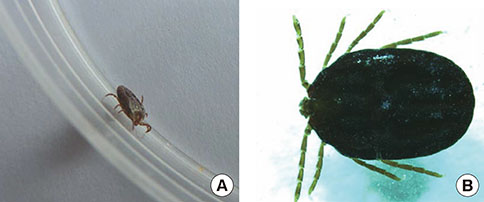Allergy Asthma Immunol Res.
2015 Jan;7(1):92-94. 10.4168/aair.2015.7.1.92.
Delayed Anaphylaxis to Red Meat Associated With Specific IgE Antibodies to Galactose
- Affiliations
-
- 1Department of Allergy, Peking Union Medical College Hospital, Chinese Academy of Medical Sciences & Peking Union Medical College, Beijing 100730, China. doctoryinjia@163.com
- 2State Key Laboratory Pathogen and Biosecurity, Beijing Institute of Microbiology and Epidemiology, Beijing, China.
- 3Department of Allergy and Immunology, National Jewish Medical and Research Center, University of Colorado, Denver, CO, USA.
- KMID: 2260158
- DOI: http://doi.org/10.4168/aair.2015.7.1.92
Abstract
- A novel delayed anaphylactic reaction to red meat, associated with tick bites and IgE antibodies against galactose-alpha-1, 3-galactose (alpha-gal), was reported in 2009 in the US, Australia and Europe. In this case, serum specific IgE to galactose-alpha-1, 3-galactose (>100 kU/L) and IgE to multiple non-primate mammalian proteins were positive. However, the pathogenesis of this disease remains unclear. We report the first case in Asia of delayed anaphylactic reaction to red meat, which was induced by bites from the hard tick, Hematophagous ixodidae. We confirmed the increased concentration of IgE reactive epitopes in non-primate mammalian organs, which may be rich in alpha-gal proteins in lymphatic and endothelial tissues. All confirmed ticks associated with this disorder in the literature and in our case belonged to the hard tick family. We hypothesize that hard tick saliva is enriched with blood-type substances, such as oligosaccharides, from the non-primate mammal victim's blood after days to weeks of blood sucking, which sensitizes humans through the injection route while blood sucking.
Keyword
MeSH Terms
Figure
Reference
-
1. Commins SP, Satinover SM, Hosen J, Mozena J, Borish L, Lewis BD, Woodfolk JA, Platts-Mills TA. Delayed anaphylaxis, angioedema, or urticaria after consumption of red meat in patients with IgE antibodies specific for galactose-alpha-1,3-galactose. J Allergy Clin Immunol. 2009; 123:426–433.2. Van Nunen SA, O'Connor KS, Clarke LR, Boyle RX, Fernando SL. An association between tick bite reactions and red meat allergy in humans. Med J Aust. 2009; 190:510–511.3. Jacquenet S, Moneret-Vautrin DA, Bihain BE. Mammalian meat-induced anaphylaxis: clinical relevance of anti-galactose-alpha-1,3-galactose IgE confirmed by means of skin tests to cetuximab. J Allergy Clin Immunol. 2009; 124:603–605.4. Morisset M, Richard C, Astier C, Jacquenet S, Croizier A, Beaudouin E, Cordebar V, Morel-Codreanu F, Petit N, Moneret-Vautrin DA, Kanny G. Anaphylaxis to pork kidney is related to IgE antibodies specific for galactose-alpha-1,3-galactose. Allergy. 2012; 67:699–704.5. Spiro RG, Bhoyroo VD. Occurrence of alpha-D-galactosyl residues in the thyroglobulins from several species. Localization in the saccharide chains of the complex carbohydrate units. J Biol Chem. 1984; 259:9858–9866.6. Vaughan HA, McKenzie IF, Sandrin MS. Biochemical studies of pig xenoantigens detected by naturally occurring human antibodies and the galactose alpha(1-3)galactose reactive lectin. Transplantation. 1995; 59:102–109.7. Commins SP, James HR, Kelly LA, Pochan SL, Workman LJ, Perzanowski MS, Kocan KM, Fahy JV, Nganga LW, Ronmark E, Cooper PJ, Platts-Mills TA. The relevance of tick bites to the production of IgE antibodies to the mammalian oligosaccharide galactose-α-1,3-galactose. J Allergy Clin Immunol. 2011; 127:1286–1293.e6.8. Nuñez R, Carballada F, Gonzalez-Quintela A, Gomez-Rial J, Boquete M, Vidal C. Delayed mammalian meat-induced anaphylaxis due to galactose-alpha-1,3-galactose in 5 European patients. J Allergy Clin Immunol. 2011; 128:1122–1124.e1.9. Chmelar J, Calvo E, Pedra JH, Francischetti IM, Kotsyfakis M. Tick salivary secretion as a source of antihemostatics. J Proteomics. 2012; 75:3842–3854.
- Full Text Links
- Actions
-
Cited
- CITED
-
- Close
- Share
- Similar articles
-
- Red meat allergy: clinical characteristics
- Carbohydrates as food allergens
- Tick-induced allergies: mammalian meat allergy, tick anaphylaxis and their significance
- A Case of Anaphylaxis after Exposure to Oral Cefaclor
- Usefulness of specific IgE antibody levels to wheat, gluten, and ω-5 gliadin for wheat allergy in Korean children




